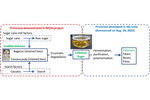Toray to install pilot facility for all-carbon CO2 separation membrane mass production
In leveraging the facility, Toray looks to upscale prototypes and conduct demonstration tests, working with biogas, natural gas production development companies and other partners to accelerate efforts toward practical application.

CO2 separation membrane structure. Source | Toray Industries Inc.
Toray Industries Inc. (Tokyo, Japan) announced that it is installing a pilot facility for its all-carbon carbon dioxide (CO2) separation membrane at its Shiga Plant. The new facility should become operational in the fiscal year starting April 1, 2025 and will be used to mass produce this membrane technology.
An all-carbon CO2 separation membrane owes its high performance to a dual layer structure, comprising a thin carbon film separation layer on the surface of a hollow fiber porous carbon fiber support. Making the support as thin as possible reduces the membrane module’s weight and size. Notably, a CO2 separation membrane element bundles all carbon CO2 separation membranes within a housing. It enables the independent recovery of gases that permeate the membrane and those that do not. Densely packing hollow fiber CO2 separation membranes inside the element enables a more compact design by making it possible to increase the membrane surface area per unit volume (read “Porous carbon fiber: Permeable, adsorptive and conductive”).
Toray says it will collaborate with biogas and natural gas production developers, related engineering manufacturers and other external partners to validate the pilot facility’s results, with the goal of putting the CO2 separate membrane elements to practical use in the following fiscal year.
CO2 emissions from natural gas are relatively low when burned, so its use as a stable energy source should continue to grow. In recent years, an emphasis on developing gas fields with low CO2 concentrations has heightened demand for more efficient CO2 separation and recovery technology in view of a need to exploit gas fields with higher residual CO2 concentrations.
Therefore, Torays believe it will be vital to develop technologies that can efficiently separate and recover CO2 from biogas derived from biomass — which is a mixture of methane and CO2 — and from waste gases containing nitrogen and CO2, using these technologies for carbon capture and storage, and carbon capture and use.
Toray research laboratories have confirmed the high separation performance and durability of its proprietary, all-carbon CO2 separation membrane in gas environments containing impurities. Moreover, the company has refined its hollow fiber spinning and thin-layer coating technologies, establishing a film production process capable of producing consistently stable membranes. Simultaneously, it developed core technology for manufacturing membrane elements that bundle CO2 separation membranes.
Using small membrane elements it created, the company successfully demonstrated CO2 separation from biogas and exhaust gas emissions at its Tokai Plant, maintaining consistent CO2 separation performance for a full week. This demonstration confirmed the technology’s applicability for separating methane and nitrogen from CO2. Additionally, the biogas used at the Tokai Plant during the demonstration contained more than 1,000 parts per million of aromatic hydrocarbons alongside CO2, for a composition similar to that of natural gas.
Toray believes the technology should find wide-ranging applications, not only in biogas but also in natural gas production and in enhancing the efficiency of CO2 separation for CCS and CCU, where CO2 separation is essential.
















